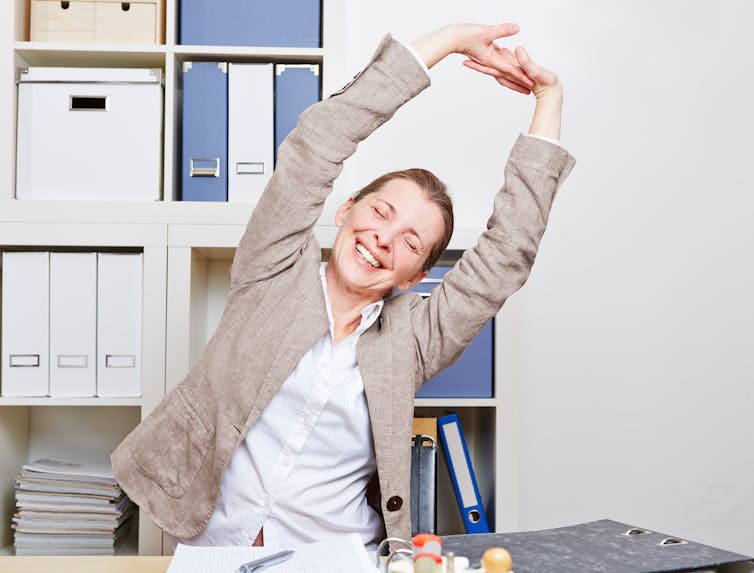

Common poor desk posture is actually very similar to the posture astronauts adopt during spaceflight in zero-gravity



Lockdown could be bad for your back. Thanks to measures to tackle the coronavirus pandemic, many of us are now working from home. This means you might not be moving around as much and your home desk setup (and the posture you adopt while working) might not be as good as it should be. These are all things that can lead to back pain.
Common poor desk posture is actually very similar to the posture astronauts adopt during spaceflight in zero-gravity. Usually this is a forward-leaning posture with a forward head position and the loss of normal spinal curves. Being in space also has similar effects to staying in bed all day.
At the Aerospace Medicine and Rehabilitation Laboratory at Northumbria University, our team of researchers look into ways of keeping the spine healthy in astronauts during space missions. But this research can also be used to help those of us on Earth keep our spines healthy when working from home.
At a very basic level, the spine is a stack of 33 bones called vertebrae. In between the vertebrae are thick jelly-like discs that provide space for the bones to move across the whole spine when we rotate or bend.
Alongside the vertebrae are many small and large muscles that either help stabilise the spine or help it generate movement. All these muscles are in a complex conversation with the brain in order to work together and maintain your upright posture and stability when sitting and moving. When even one of these vertebrae, discs or muscles becomes irritated, it can lead to back pain.
When you lean forward a lot you stop using the small postural muscles that control the spine’s normal curve. Over time, they become smaller, weaker, and don’t activate properly when needed. So if you’re working at home, you might find our our advice to astronauts helpful.
Four tips to help you keep your spine healthy
1. Move. Try to take a few moments to move around every one to two hours during the work day. For your spine this means gently rotating, leaning forwards, backwards and sideways. Avoid extreme ranges and don’t use weights or resistance to do this. Think of it like oiling the joints and moving that oil around by gently moving them.

2. Sort out your setup. While on the International Space Station, astronauts float rather than sitting. So they’re encouraged to keep a normal, upright position as much as possible, as well as exercising to maintain back strength. To keep good posture on Earth, making sure you set up your desk, chair and home office equipment correctly is key.
Ensure your screen is directly in front of you, with the middle of your screen at eye level. Be sure to sit back in a good chair that is upright and not reclined. Have your keyboard level, right in front of you, with your elbows by your side and at 90 degrees, ideally with wrists supported too. Make sure your feet are also flat on the floor in front of you.
3. Aim for a ‘neutral’ upright posture. Try to avoid leaning forwards. Maybe even get someone to check your posture from the side. If you look hunched over, are leaning forwards or craning your neck back to see your screen, then you have a high chance of developing spinal pain. You can reset to good posture by:
4. Exercise. If, like our astronauts, you have some weak spinal stability muscles from poor posture — or not enough exercise from lockdown (or in their case, spaceflight) — some spinal exercises might help. Things like beginner level pilates exercises can help strengthen your spine.
But remember to gently suck in your belly button towards your spine (to about 30-40 per cent of your max power but not 100 per cent) during your exercise as this can help engage the right muscles. Remember to move around every hour or two. At the end of the day, a walk may also help minimise back pain and build strength.
Of course, being in gravity is ultimately different to floating in space. If you find your spinal problems aren’t improving, seeing a physiotherapist may be useful to getting specific exercises tailored to you.![]()
Andrew Winnard, Lead for the Aerospace Medicine Systematic Review Group and Lecturer, Northumbria University, Newcastle and Nick Caplan, Professor of Aerospace Medicine and Rehabilitation, Northumbria University, Newcastle
This article is republished from The Conversation under a Creative Commons license. Read the original article.
We are a voice to you; you have been a support to us. Together we build journalism that is independent, credible and fearless. You can further help us by making a donation. This will mean a lot for our ability to bring you news, perspectives and analysis from the ground so that we can make change together.

Comments are moderated and will be published only after the site moderator’s approval. Please use a genuine email ID and provide your name. Selected comments may also be used in the ‘Letters’ section of the Down To Earth print edition.